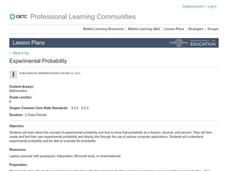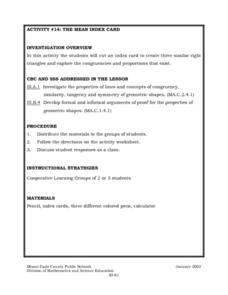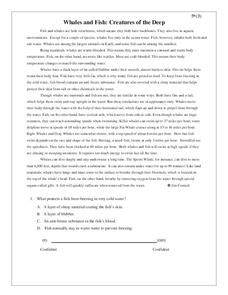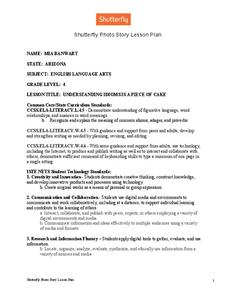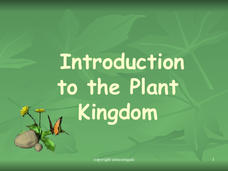Curated OER
Vocabulary Practice: Similar or Opposite?
In this similar or opposite vocabulary worksheet, students choose words from a word bank to complete a chart. Students write nine synonyms and antonyms.
Curated OER
Vocab-u-lous! Build a Fabulous Vocab
In this vocabulary learning exercise, students decipher the best word choice to complete the sentence. All words begin with the letter T.
Curated OER
Experimental Probability
While just a simple lesson, this activity on experimental probability could provide a way to connect this concept to real life. Learners begin by participating in a probability activity using a coin, and then move on to create their own...
Curated OER
Using Similes and Metaphors in Poetry
The use of similes and metaphors will become more clear and your students will gain knowledge and comprehend the meanings of the words with these activities. They compose interesting similes and metaphors based on visual prompts and...
Curated OER
Formal and Informal Language
ESL students use the graphic organizers to record different phrases of speech with an emphasis upon the use of slang.
Curated OER
Go Fish for Antonyms
Third graders, after reading and discussing the book, "One Fish Two Fish," by Dr. Seuss, practice matching pairs of antonyms together with an accuracy of 12 out of 15. They make flashcards in the shape of fish to study with and play a...
Curated OER
THE MEAN INDEX CARD
Students cut an index card to create three similar right triangles and explore the congruencies and proportions that exist. They investigate the properties of lines and concepts of congruency, similarity, tangency and symmetry of...
Houghton Mifflin Harcourt
Celebrating Traditions: Extra Support Lessons (Theme 2)
Third graders needing extra support will benefit from the materials contained in this 42-page packet designed to be used with the Houghton Mifflin Harcourt textbook thematic unit celebrating traditions.
Curated OER
Whales and Fish: Creatures of the Deep
Practice comparing and contrasting details in informational text with a reading passage about whales. It explains the ways that fish and whales are similar, as well as the ways they are different, and specific characteristics of various...
Shutterfly
Photo Story Lesson Plan
After reading Loree Leedy's There's a Frog in My Throat: 440 Animal Sayings a Little Bird Told Me, kids create and illustrate their own poems that convey the meaning of an idiom. The poems are then transferred into Shutterfly's Photo...
Biology Junction
Introduction to the Plant Kingdom
Plants provide humans with food, shelter, and medications. Scholars gain a better appreciation for plants after learning their functions, divisions, and early ancestors. Each sub-topic includes slides highlighting vocabulary and...
Curriculum Corner
“I Can” Common Core! 3rd Grade Reading
Third grade readers are given clear learning goals with this Common Core checklist. By turning each reading standard into an I can statement, children can focus on mastering the required grade level skills.
Chymist
Visualizing pH
Why are acids and bases important in our daily lives? Lead the class in answering this question, among others, as they experiment with pH paper and classify where various substances belong on the pH scale. They also taste common acids...
The Alamo
A Lesson in Citizenship
What does it mean to be an American citizen? Lieutenant Colonel Commander William Barret Travis believed that it meant honor to country first—even above one's own life. Middle and high schoolers read his final letters from the Alamo that...
Novelinks
Sense and Sensibility: Final Assessment: Movie Maker
Assess your class's understanding of Jane Austen's Sense and Sensibility with a fun and creative final project. Using what they have learned about the novel's characters, they create presentations featuring music and images that best...
Soft Schools
Metaphors: Understanding Comparisons
Here's a metaphor instructional activity that asks kids to identify the two things being compared and then to explain the similar characteristics that are being identified.
Maine Content Literacy Project
Introduction to The Lottery, by Shirley Jackson
"The Lottery" by Shirley Jackson is a great story to share with your class, and this lesson focuses on just that story! The eighth in a fourteen-lesson series on short stories, the plan has learners study some vocabulary, read the story,...
Willow Tree
Patterns - Numbers, Shapes, etc.
Find the pattern is the name of the game! Learners examine different patterns represented by numbers, shapes, and words. They must describe the pattern, predict the result in a given position, and find an equation that represents a...
Hood River County School District
Text Structure: Features and Organization
Teach learners how to interact with both fiction and non-fiction text with a packet of activities and worksheets. After looking over text structure and the difference in text features between different types of writing, readers analyze...
Reed Novel Studies
The Mouse and The Motorcycle: Novel Study
A mouse on a motorcycle—what could possibly go wrong? Using the novel study that accompanies Beverly Cleary's The Mouse and the Motorcycle, pupils complete a brief vocabulary activity and then answer questions about the text. Next, they...
Virginia Department of Education
Radical Equations
Provide students with the skill for how to examine algebraic and graphical approaches to solving radical equations. Learners solve various radical equations involving square root and cube root expressions. They first solve using...
Reed Novel Studies
Theodore Boone - Kid Lawyer: Novel Study
A child lawyer is exactly what people need ... not! With the novel study for John Grisham's Theodore Boone: Kid Lawyer, pupils use their imaginations to create their own examples of sarcasm. They also research a chosen famous lawyer and...
Curated OER
Whether/Weather/Wether
Is it whether, weather, or wether? Learners explore the differences between these three words using examples and descriptions. They conclude by taking an interactive test.
Curated OER
Vocabulary Practice: Complete the Sentence
In this vocabulary practice learning exercise, students read ten sentences and analyze the word in italics. Students find a word in the word box that has a similar meaning as the italicized word.




